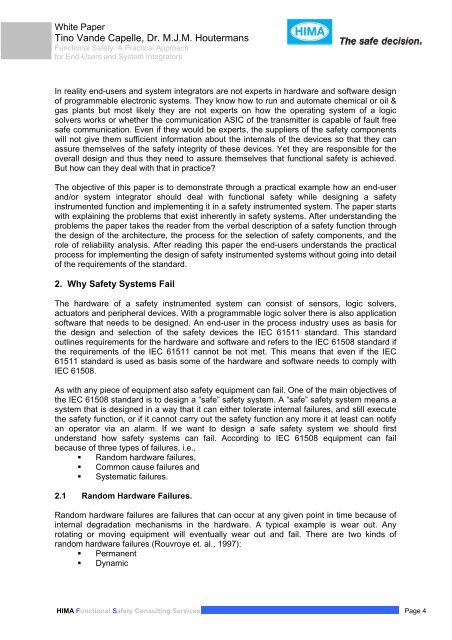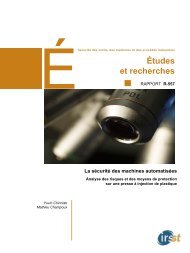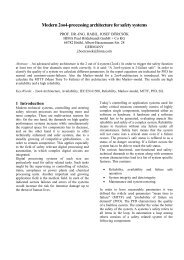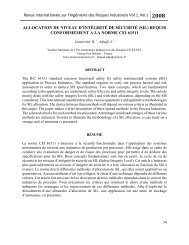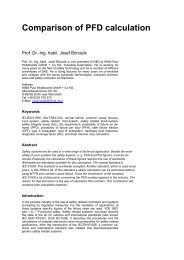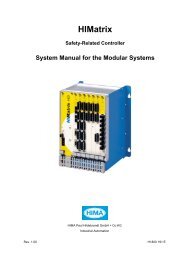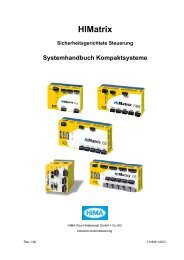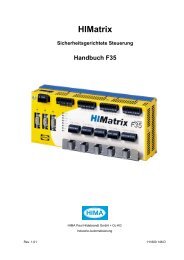Functional Safety
Functional Safety
Functional Safety
You also want an ePaper? Increase the reach of your titles
YUMPU automatically turns print PDFs into web optimized ePapers that Google loves.
White Paper<br />
Tino Vande Capelle, Dr. M.J.M. Houtermans<br />
<strong>Functional</strong> <strong>Safety</strong>: A Practical Approach<br />
for End-Users and System Integrators<br />
In reality end-users and system integrators are not experts in hardware and software design<br />
of programmable electronic systems. They know how to run and automate chemical or oil &<br />
gas plants but most likely they are not experts on how the operating system of a logic<br />
solvers works or whether the communication ASIC of the transmitter is capable of fault free<br />
safe communication. Even if they would be experts, the suppliers of the safety components<br />
will not give them sufficient information about the internals of the devices so that they can<br />
assure themselves of the safety integrity of these devices. Yet they are responsible for the<br />
overall design and thus they need to assure themselves that functional safety is achieved.<br />
But how can they deal with that in practice?<br />
The objective of this paper is to demonstrate through a practical example how an end-user<br />
and/or system integrator should deal with functional safety while designing a safety<br />
instrumented function and implementing it in a safety instrumented system. The paper starts<br />
with explaining the problems that exist inherently in safety systems. After understanding the<br />
problems the paper takes the reader from the verbal description of a safety function through<br />
the design of the architecture, the process for the selection of safety components, and the<br />
role of reliability analysis. After reading this paper the end-users understands the practical<br />
process for implementing the design of safety instrumented systems without going into detail<br />
of the requirements of the standard.<br />
2. Why <strong>Safety</strong> Systems Fail<br />
The hardware of a safety instrumented system can consist of sensors, logic solvers,<br />
actuators and peripheral devices. With a programmable logic solver there is also application<br />
software that needs to be designed. An end-user in the process industry uses as basis for<br />
the design and selection of the safety devices the IEC 61511 standard. This standard<br />
outlines requirements for the hardware and software and refers to the IEC 61508 standard if<br />
the requirements of the IEC 61511 cannot be not met. This means that even if the IEC<br />
61511 standard is used as basis some of the hardware and software needs to comply with<br />
IEC 61508.<br />
As with any piece of equipment also safety equipment can fail. One of the main objectives of<br />
the IEC 61508 standard is to design a “safe” safety system. A “safe” safety system means a<br />
system that is designed in a way that it can either tolerate internal failures, and still execute<br />
the safety function, or if it cannot carry out the safety function any more it at least can notify<br />
an operator via an alarm. If we want to design a safe safety system we should first<br />
understand how safety systems can fail. According to IEC 61508 equipment can fail<br />
because of three types of failures, i.e.,<br />
� Random hardware failures,<br />
� Common cause failures and<br />
� Systematic failures.<br />
2.1 Random Hardware Failures.<br />
Random hardware failures are failures that can occur at any given point in time because of<br />
internal degradation mechanisms in the hardware. A typical example is wear out. Any<br />
rotating or moving equipment will eventually wear out and fail. There are two kinds of<br />
random hardware failures (Rouvroye et. al., 1997):<br />
� Permanent<br />
� Dynamic<br />
HIMA <strong>Functional</strong> <strong>Safety</strong> Consulting Services Page 4


